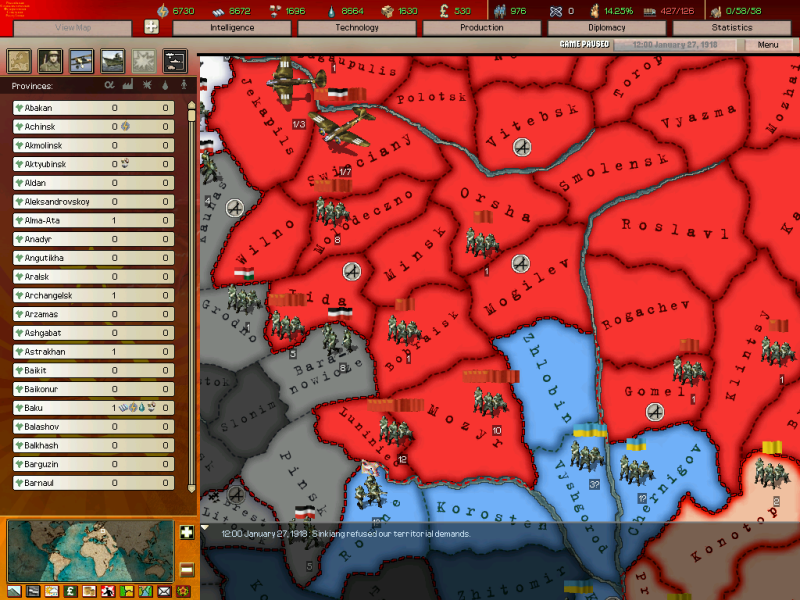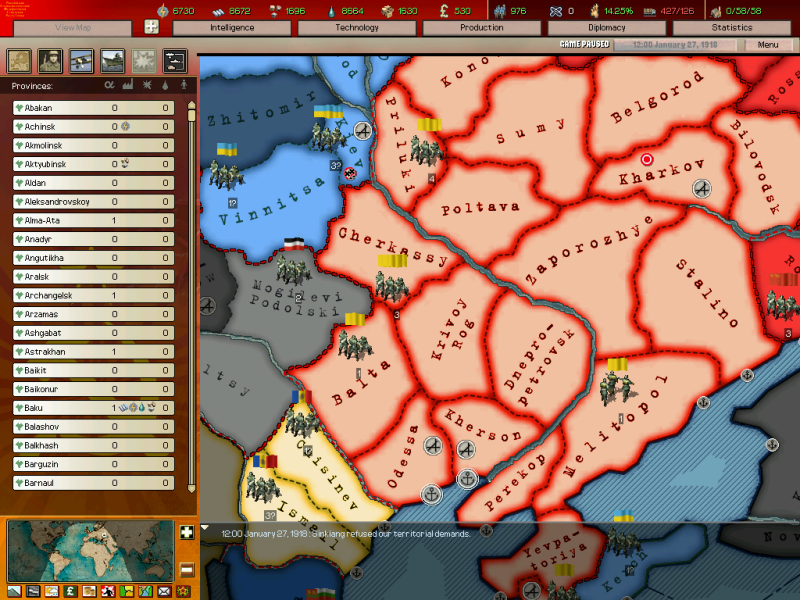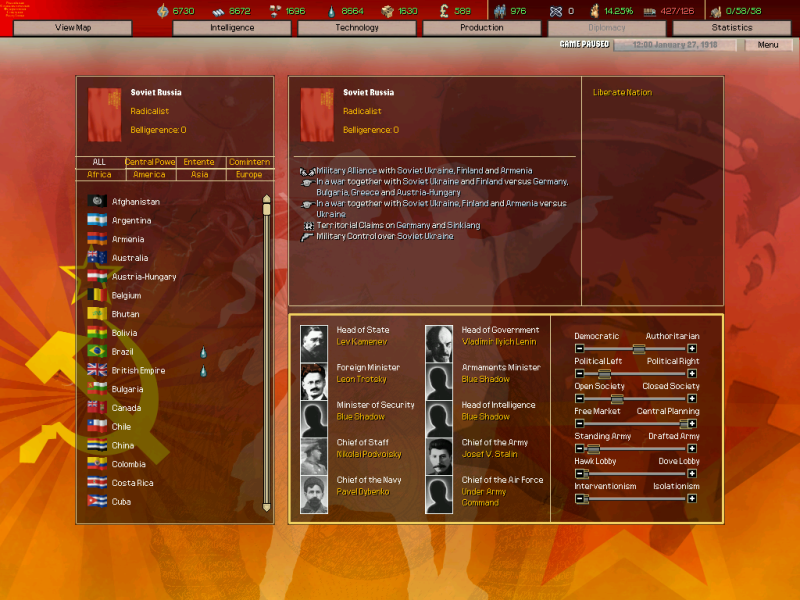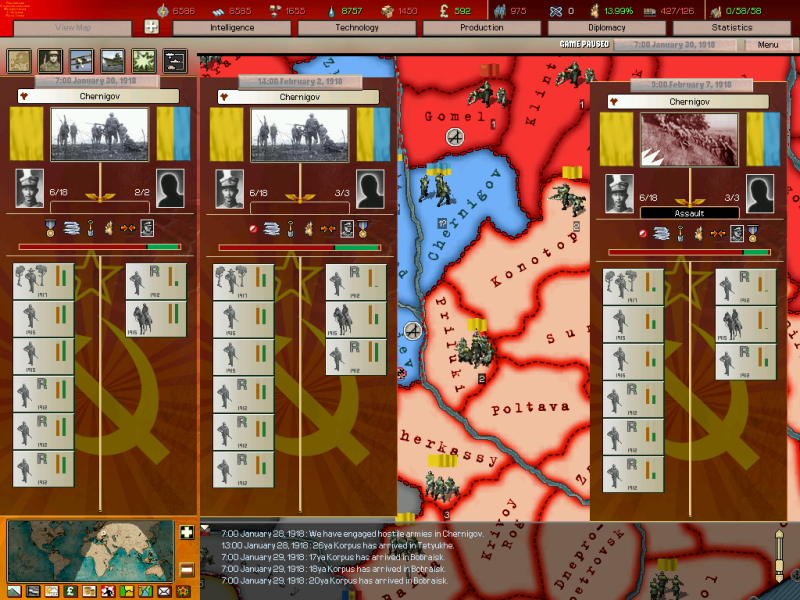Hello everyone!
This is a rather unique Soviet Russia AAR which starts from 1918, but which originally began in the 1914 scenario. The young soviet republic is under attack from all sides and is going to have a very hard time holding its own. It is currently at war with the Central Powers while trying to deal with an Ukrainian rebellion and partisans all around. My goal is to win the civil war and hold off the Germans... or at least win the civil war.
So, let us begin! If this gathers enough interest I'll continue.
---
The Empire of Russia entered the Great War in 1914, full of promise. The Tsarist system was already cracking, but its military was still a juggernaut. The vast empire, which stretched from Poland to the Pacific Ocean, seemed indestructible back then and both the Tzar, his advisors and his people were confident that the victory against Germany would be an easy one.
The illusion was shattered almost straight away. Germany and Austria-Hungary went on the offensive against Russia, pushing them entirely out of Congress Poland - and even further - by the winter of 1915. City after city was lost to the Central Powers while the Ottomans were barely held off in the Caucasus. Tzar Nicholas personally took command of the army, but that didn't help, and by 1916 the city of Kiev was under siege, while in the north, German troops were threatening to break through into Estonia. The Ottoman Empire fell to a British offensive from Mesopotamia and Egypt in this year, freeing up troops to be delivered westwards, which finally stalled the German-Austro-Hungarian attacks.
The Austro-Hungarian warmachine finally collapsed in 1917, when Italian troops marched to Vienna in a glorious offensive. This was Russia's time to shine; but the Tzar would no longer take glory for the successes of the Russian army in the summer of 1917. In March, owing to the famines and poverty caused by the war, the people rose up in revolution. A constitutional monarchy was established under Alexis II, with the real power in the hands of Prince Georgy Lvov. This government reversed the failures on the Eastern Front and pushed back the Central Powers considerably.
But even these events failed to save the monarchy. Disgruntled by the fact that the government didn't carry through with its promises to make peace and distribute land, the Bolsheviks continued agitating against the new Tzar. After a failed coup by military man Lavr Kornilov, the Reds remained as the sole challengers of the Russian establishment. The monarchy collapsed in early November and all power was delivered into the hands of the soviets.
The revolution shocked the world. The Entente lost a loyal ally, but more importantly, they had to face a new idea, a new kind of system, one that threatened to spread like an infection through the cells of the body and topple the ancien regimes. Still, they weren't able to do anything: France was, by now, overrun by Germany and the rest of the Entente was only desparately holding on to its beachhead in northern France.

The governments of Finland and Ukraine were the first to take advantage of the chaotic situation, rising up in rebellion against the Soviets. The Kamenev-Lenin-Trotsky troika quickly consolidated power, banishing the less revolutionary SRs and Mensheviks from the Constitutional Assembly. The Bolshevik-dominated government immediately directed its forces to regain Ukraine - enlisting the help of Nestor Makhno's Soviet Ukrainian movement - while recognising the independence of Finland and accepting them as an ally against the German menace.
Ceasefire negotiations began with Germany soon, but they ended up being fruitless. The Germans refused to make peace without significant annexations, which the Bolsheviks wouldn't accept. Trotsky offered to unilaterally end hostilities - this would be called the "no peace, no war" policy - but the Germans ignored this gesture. In the end, Soviet troops were ordered to hold their ground when possible and retreat against superior numbers, but to attempt no counteroffensive. While Trotsky essentially failed to secure peace, his policy ended up gaining the support of numerous workers and peasants who were ready to defend their homeland.
The core of the Soviet force is now (on the 27th of January) concentrated against Ukraine. The Hetmanate is under siege from all sides: by Soviet Russia and Soviet Ukraine, as well as the Germans who are occupying Western Ukraine for security reasons. The Whites have already begun to move against the Soviet government. The Caucasus is in all-out rebellion, and is the strongest base of the dissenters. Isolated regions in the Far East and Siberia are also under partisan control; rebel groups are trying to capture Siberian industry without much success.
The situation as of 27 January, 1918 is as follows:
Soviet-German-Ukrainian front

South Ukrainian front

The Caucasus

The Far East

These comrades are responsible for winning the civil war (as you can see, the 1914 mod has some problems, including missing ministers, but the most important people are there):

This is a rather unique Soviet Russia AAR which starts from 1918, but which originally began in the 1914 scenario. The young soviet republic is under attack from all sides and is going to have a very hard time holding its own. It is currently at war with the Central Powers while trying to deal with an Ukrainian rebellion and partisans all around. My goal is to win the civil war and hold off the Germans... or at least win the civil war.
So, let us begin! If this gathers enough interest I'll continue.
---
The Empire of Russia entered the Great War in 1914, full of promise. The Tsarist system was already cracking, but its military was still a juggernaut. The vast empire, which stretched from Poland to the Pacific Ocean, seemed indestructible back then and both the Tzar, his advisors and his people were confident that the victory against Germany would be an easy one.
The illusion was shattered almost straight away. Germany and Austria-Hungary went on the offensive against Russia, pushing them entirely out of Congress Poland - and even further - by the winter of 1915. City after city was lost to the Central Powers while the Ottomans were barely held off in the Caucasus. Tzar Nicholas personally took command of the army, but that didn't help, and by 1916 the city of Kiev was under siege, while in the north, German troops were threatening to break through into Estonia. The Ottoman Empire fell to a British offensive from Mesopotamia and Egypt in this year, freeing up troops to be delivered westwards, which finally stalled the German-Austro-Hungarian attacks.
The Austro-Hungarian warmachine finally collapsed in 1917, when Italian troops marched to Vienna in a glorious offensive. This was Russia's time to shine; but the Tzar would no longer take glory for the successes of the Russian army in the summer of 1917. In March, owing to the famines and poverty caused by the war, the people rose up in revolution. A constitutional monarchy was established under Alexis II, with the real power in the hands of Prince Georgy Lvov. This government reversed the failures on the Eastern Front and pushed back the Central Powers considerably.
But even these events failed to save the monarchy. Disgruntled by the fact that the government didn't carry through with its promises to make peace and distribute land, the Bolsheviks continued agitating against the new Tzar. After a failed coup by military man Lavr Kornilov, the Reds remained as the sole challengers of the Russian establishment. The monarchy collapsed in early November and all power was delivered into the hands of the soviets.
The revolution shocked the world. The Entente lost a loyal ally, but more importantly, they had to face a new idea, a new kind of system, one that threatened to spread like an infection through the cells of the body and topple the ancien regimes. Still, they weren't able to do anything: France was, by now, overrun by Germany and the rest of the Entente was only desparately holding on to its beachhead in northern France.

The governments of Finland and Ukraine were the first to take advantage of the chaotic situation, rising up in rebellion against the Soviets. The Kamenev-Lenin-Trotsky troika quickly consolidated power, banishing the less revolutionary SRs and Mensheviks from the Constitutional Assembly. The Bolshevik-dominated government immediately directed its forces to regain Ukraine - enlisting the help of Nestor Makhno's Soviet Ukrainian movement - while recognising the independence of Finland and accepting them as an ally against the German menace.
Ceasefire negotiations began with Germany soon, but they ended up being fruitless. The Germans refused to make peace without significant annexations, which the Bolsheviks wouldn't accept. Trotsky offered to unilaterally end hostilities - this would be called the "no peace, no war" policy - but the Germans ignored this gesture. In the end, Soviet troops were ordered to hold their ground when possible and retreat against superior numbers, but to attempt no counteroffensive. While Trotsky essentially failed to secure peace, his policy ended up gaining the support of numerous workers and peasants who were ready to defend their homeland.
The core of the Soviet force is now (on the 27th of January) concentrated against Ukraine. The Hetmanate is under siege from all sides: by Soviet Russia and Soviet Ukraine, as well as the Germans who are occupying Western Ukraine for security reasons. The Whites have already begun to move against the Soviet government. The Caucasus is in all-out rebellion, and is the strongest base of the dissenters. Isolated regions in the Far East and Siberia are also under partisan control; rebel groups are trying to capture Siberian industry without much success.
The situation as of 27 January, 1918 is as follows:
Soviet-German-Ukrainian front

South Ukrainian front

The Caucasus

The Far East

These comrades are responsible for winning the civil war (as you can see, the 1914 mod has some problems, including missing ministers, but the most important people are there):











